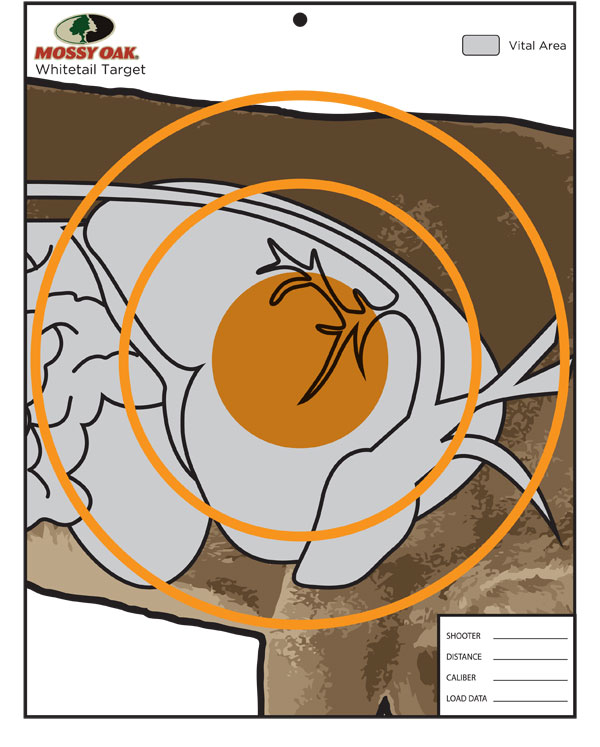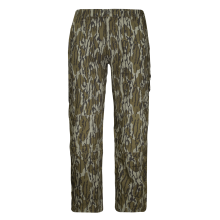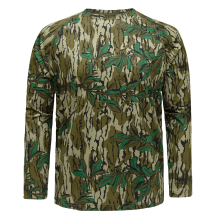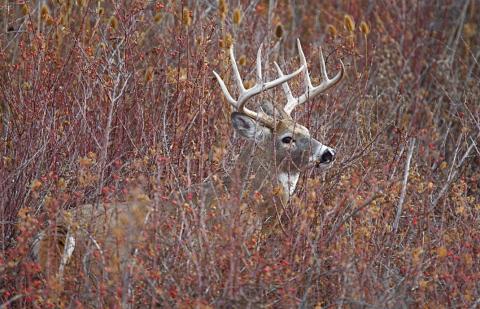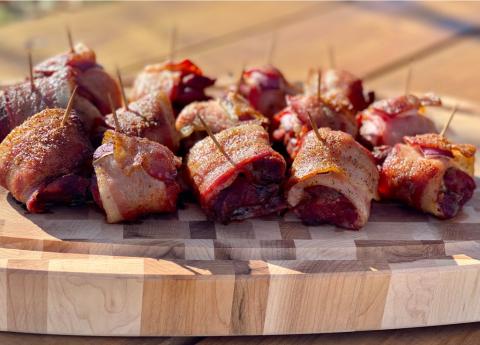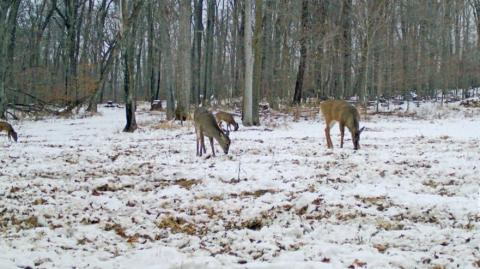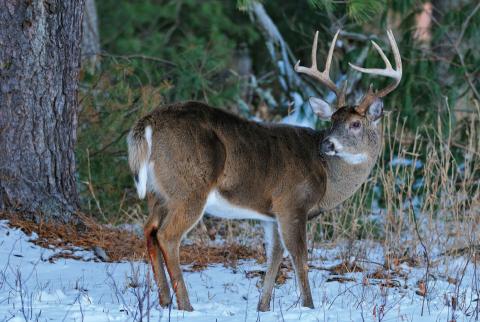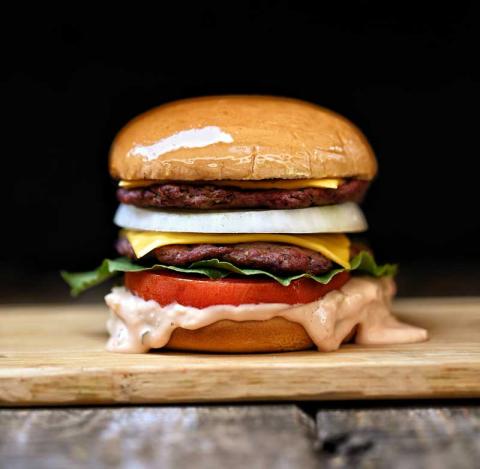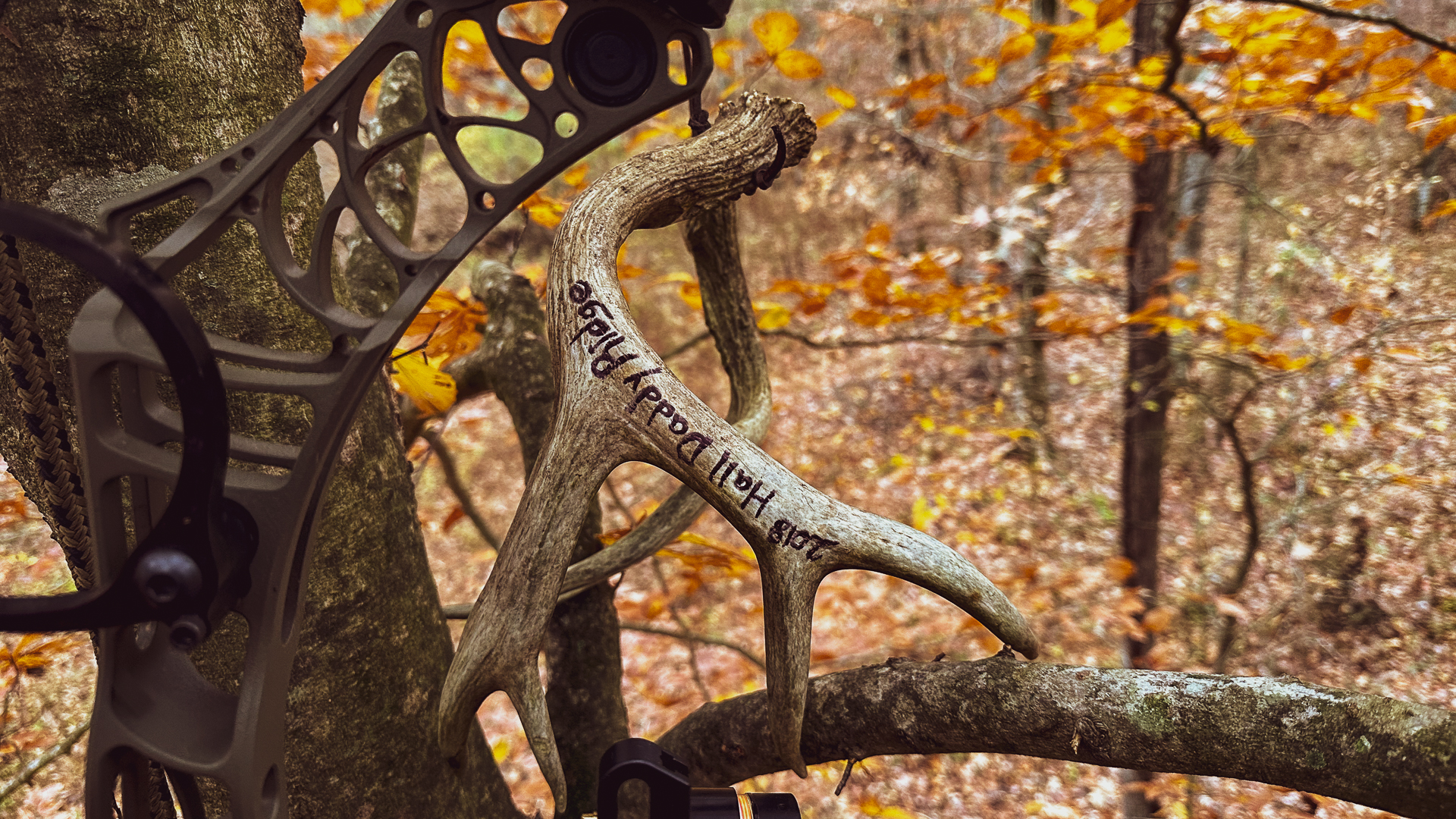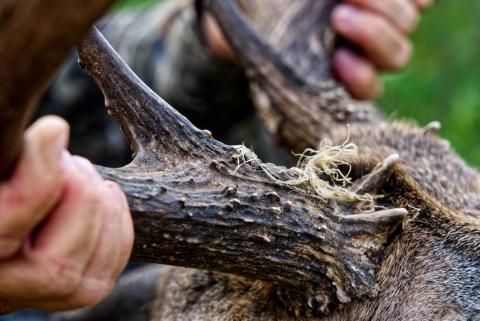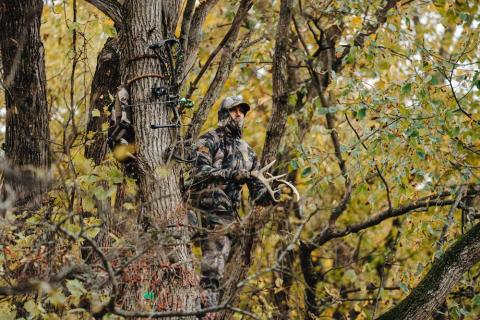
Whether you’re hunting white-tailed deer in Texas or mule deer in North Carolina, learning where to shoot a deer is the most important skill a new hunter should hone. It's essential to visualize your shot placement and know where you're planning to hit vitals.
Being almost lined up with their quarry is one of the situations that hunters usually get aggravated over since it carries so much weight. Deer will seldom line up perfectly for your bow or gunshot. Add in the complexity-increasing aspects of some hunts like treestands, and you’ll see why so many dread this kind of crunch time.
While no one is perfect at shot placement, getting it down is one of the more critical aspects of hunting. To help you improve, we've devised the ultimate guide for those looking to improve their shot placement. This guide will help you understand exactly where you need to aim and the path your bullet or arrow will take through the deer's vitals.
Understanding Buck Fever
When you’re out deer hunting, you may hear the term "buck fever." This term refers to the nervousness that a hunter might experience when they first have a buck in their sights. Buck fever causes sweaty palms, shaking, an increased pulse rate, shortness of breath, and just about any other form of in-the-moment anxiety.
One thing’s for sure: Buck fever will mess up your shots, so learning the best shot placements will help keep you accurate. Nailing your shot placement when you have a whitetail deer in your sights is essential. It’s sometimes the wealth of choices that’s your worst enemy. You’ll be indecisive about taking a neck shot, lung shot, or heart shot. Meanwhile, the chance might be slipping through your fingers.
Understanding Deer Anatomy
Big game, like deer, are built tough, so you must aim correctly for their vital organs, which is why placements come in handy. Experienced deer hunters understand that the heart, lungs and, to a lesser degree, the liver comprise a large targetable area of vitals along the front end of the animal. When aiming for this portion of the chest cavity, it’s possible to hit the animal in both lungs, which is a very low-risk shot with a fast kill time, which means a short retrieval time.
These sit right behind the front shoulder in the chest cavity. The top of the heart is partially obstructed by the lungs, and the liver is slightly further back behind the diaphragm. Using this portion of the chest as an aiming point is useful. Almost any shot with standard arrows, broadhead arrows, or gun ammo will result in an easy-to-follow blood trail and, most likely, a short tracking session.
Eye Level Shot Placements
It’s exciting to be eye-to-eye with deer in a ground archery blind or when you’re on a spot-and-stalk hunt. Every move you make is seen, your scent is more noticeable, and your aiming point can be different each time. Even the best deer rifle can’t help you overcome bad shot placement. Let’s look at different strategies for hunting while you’re on the ground.
Eye-Level Quartering-Toward Shot
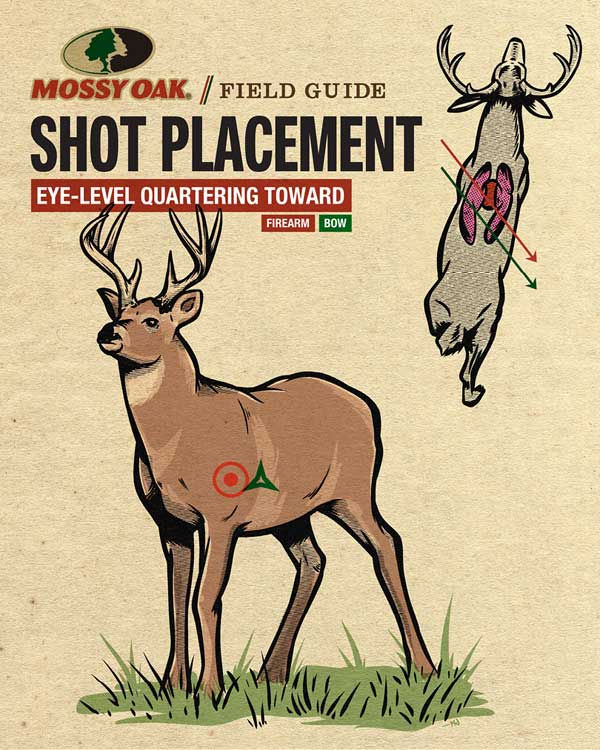
The quartering-toward shot, which is also known as a quartering-to shot, is a tough shot for a bowhunter. Often, it is best to wait for the deer to give you a better angle. If you are a veteran bowhunter and confident you can make the quartering-to shot, your aiming point should be right behind the elbow of the lead leg. At 15 yards or less, wait for the deer to move the lead leg forward and take your shot. The goal is to hit the lung and liver of the animal.
The quartering-to-shot is not a horrible angle for rifle hunters, but not ideal either. If the deer is not going to give you a better angle, then aim right behind the elbow of the lead leg. Other choices are between the lead leg and breastplate or the high shoulder. Hunters should avoid the shoulder socket; this is not a great choice for any weapon.
Eye-Level Quartering-Away Shot
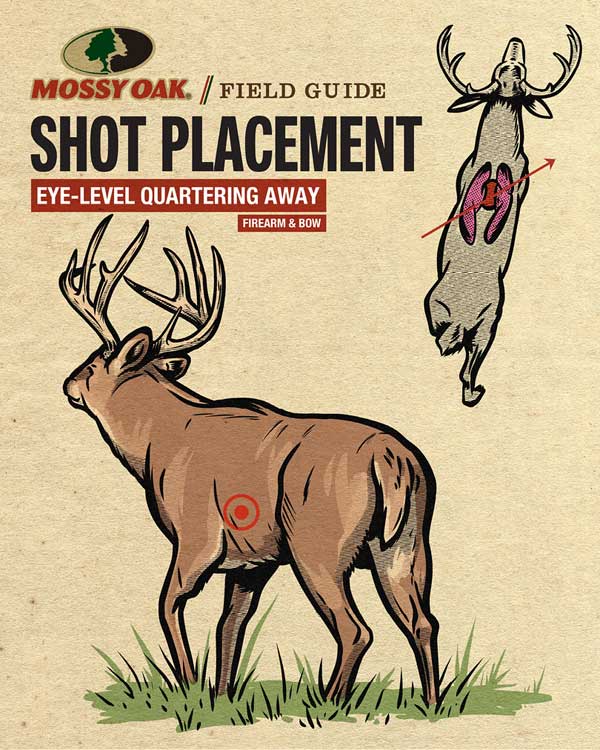
The quartering-away shot is the bowhunter’s dream. The deer is less likely to see you draw your bow, and important vitals are exposed. It’s best to aim for the opposite shoulder shot and worry less about the point of entry. When you hit the opposite shoulder, you have sent an arrow through the vitals and the tracking job is usually short and sweet.
The quartering-away shot for rifle hunters is extremely lethal.
Ideally, the opposite shoulder is taken out, and the deer doesn't travel far. It is best to aim for the opposite shoulder, knowing you will take out most of the animal’s vitals along the way. Let a young hunter sit in a stand that will likely have a quartering-away shot. The success rate is high, and they will never forget the hunt.
The Eye-Level Broadside Shot
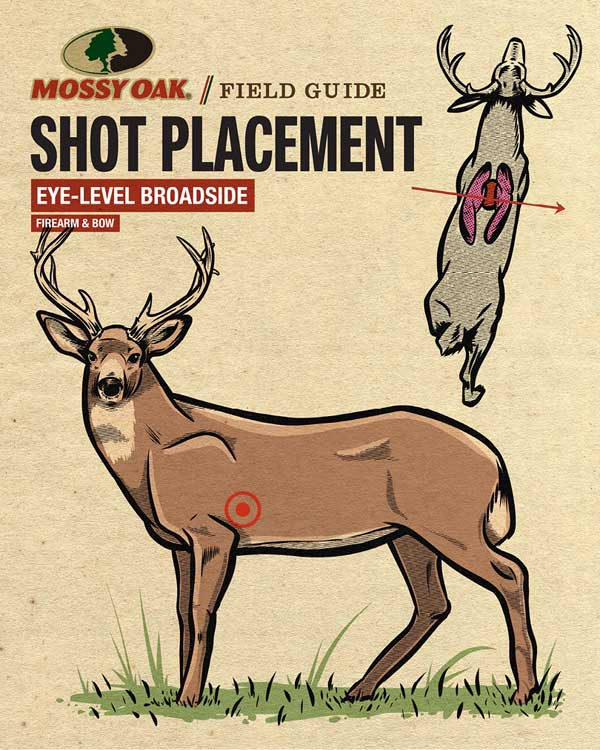
The broadside shot is one bowhunters should not hesitate to take. Find a tuft of hair or a spot of mud just behind the lower shoulder blade. You are trying to aim at something small in hopes of missing small. A tuft of hair is often easier to aim at than the entire side of a deer. The goal is a clean pass-thru for a quick kill and an easier tracking job.
The broadside shot for the large caliber hunters is more challenging than one might think. A high-shoulder shot here is ideal. The animal will go down right away, and a follow-up shot is seldom needed. Don’t take this shot for granted; stay focused, and you will soon load this deer in the truck.
Elevated Shot Placements
Hunters in treestands or elevated blinds have a distinct advantage. Their scent is harder to detect, their movement is often not noticed, and they have a greater field of view. The disadvantage can be that shot placement is different from an elevated position than it would be if you were positioned on the ground. Let’s look at other strategies from an elevated stand or blind.
The Elevated Quartering-Toward Shot

The quartering-to-shot for bowhunters is not ideal. If the deer is not going to give you a better angle, then the point of aim is just above and behind the elbow of the lead leg. Your best chance to hit the lungs and liver is when the deer moves its front foot forward. Remember, with an elevated shot, the exit point is as important as the entry point.
The quartering-to shot for rifle hunters is not the ideal shot to take, but it’s not the worst. Much like the bowhunter, you want to aim right behind and slightly above the elbow of the lead leg. Ideally, you can wait until the lead leg is forward. You can also use the area between the lead leg and breastplate for a more lethal shot.
The Elevated Quartering-Away Shot
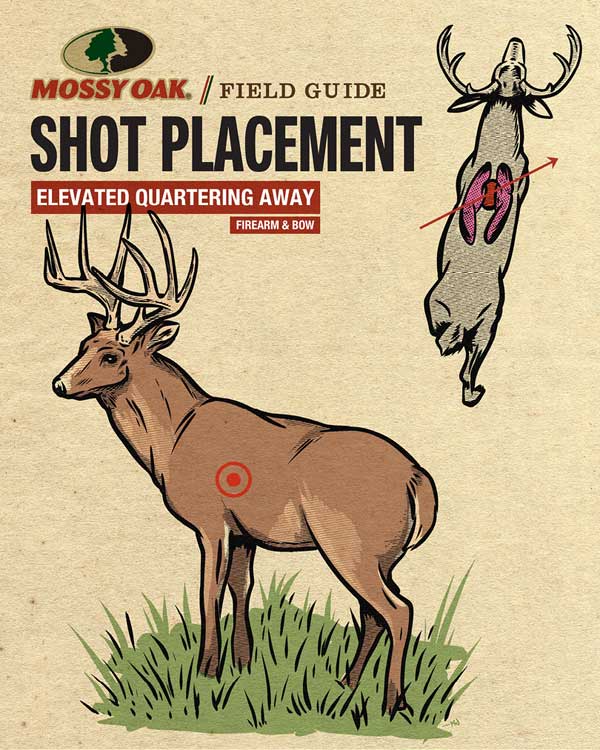
The elevated quartering-away shot will give any bowhunter buck fever. Bowhunters know this angle will expose important vitals, and the likelihood of jumping the string is low. Make sure your shooting lanes are clear and aim for the opposite shoulder. Your entry point may seem high, but you will have a clean kill as your arrow travels through the animal’s vital organs.
A rifle hunter making an elevated quartering-away shot should also aim at the opposite shoulder. With an accurate shot, this deer is going down. Not everyone thinks about a quartering-away shot when setting up a tree stand. Make sure you have a clean window to shoot through as the deer walks by.
The Elevated Broadside Shot
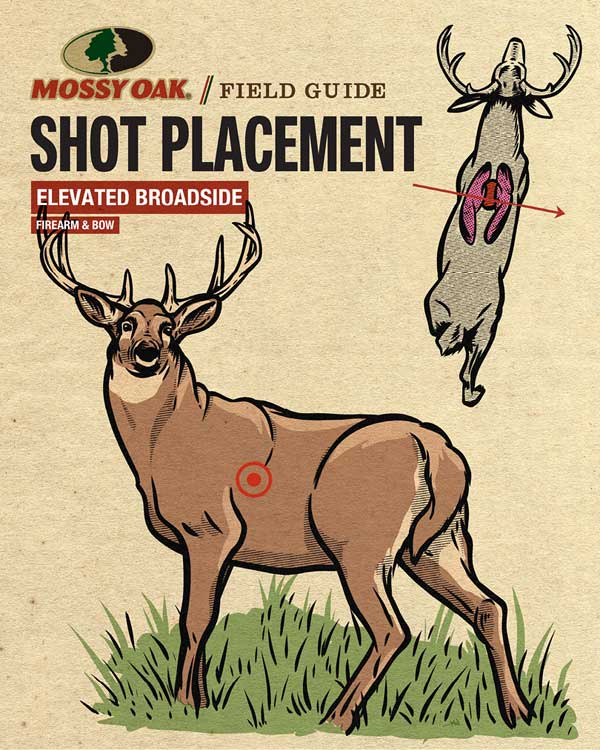
The elevated broadside shot is what every bowhunter plans for, especially when positioned at a higher vantage. Shooting lanes are trimmed, and corn is left in the perfect spot to stop the deer broadside. Your aim should be right behind the elbow of the front leg. Not too high since broadside deer are notorious for dropping on the shot. Visualize the shot before and during firing. Relax and don’t overthink the shot; this is what you have waited for.
The elevated broadside shot for a rifle hunter is the stuff dreams are made of. The high shoulder is a great aiming point — this spot often drops the deer very quickly. If you’re filming your hunt with a scope-mounted camera, make sure you stay on the deer after the recoil. Often, this shot results in the deer going down on camera.
Have a Strategy
Many hunters don’t think about shot strategy until the deer is in front of them. This lack of planning only adds to buck fever, which will lower your chances to nil. There are other angles to consider, but they generally end with the walk of shame. For example, neck, spine, abdomen, or headshots are potentially useful, but in most cases, they pose too high of a shot risk to be viable.
In our guide, we discussed how the quartering-toward, quartering-away, and broadside shot strategies will help you make an ethical and lethal shot. These techniques are tried-and-true and promise the best success rates in your hunts.
